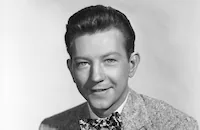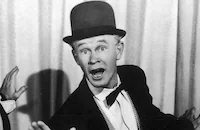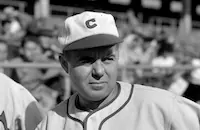Patrick the Great
Cast & Crew
Frank Ryan
Donald O'connor
Peggy Ryan
Frances Dee
Donald Cook
Eve Arden
Film Details
Technical Specs

Synopsis
Musical comedy star Pat Donahue is the toast of Broadway in the show Gypsy Love . On the last night of the musical's highly successful run, his teenage son, Pat, Jr., causes a stir when, from the audience, he recites his father's well-worn farewell speech along with him. Pat soon discovers that his son and his girl friend, Judy Watkins, have come to New York to borrow the play's old sets and costumes for their boarding school's theatrical workshop. When theatrical producer Max Wilson is convinced by Pat, Jr. to direct the workshop's next production, Prentis Johns, the noted English playwright, agrees to join Max in order to work on his new musical, Everything Goes . Prentis is so taken by the teenagers that he allows them to stage his play as a work-in-progress. After seeing the workshop's production, Prentis convinces Max to cast Pat, Jr. in the lead of the play's Broadway production, a role his father had been planning to play. In order to prepare for the role, Pat, Jr. goes to see his father at a vacation lodge. With Pat away on a fishing trip, Pat, Jr. wanders down to the lake to rehearse. His singing attracts the attention of Lynn Andrews, a cook book author, and her secretary, Jean Mathews. Thinking that Pat, Jr.'s heart has been broken, Lynn tries to take his mind off his heartache by pretending to be a damsel in distress. Her plan works until Pat, Jr. overhears the two women laughing at him. Lynn and Pat, Jr. soon make up, and he becomes convinced that the older woman is in love with him. When Pat and Sam Bassett, his agent, return to the lodge, Pat, Jr. finally learns that he has been cast in his father's part. Unwilling to tell his father the truth, Pat, Jr. then pretends to have been cast in another production. In order to keep his father from receiving Max's explanatory phone call that evening, Pat, Jr. persuades his father to join him for dinner with Lynn. When Pat, Jr. sneaks back up to his father's room to take Max's call, Sam overhears the young man turn down the part out of loyalty to Pat. The agent then tries to convince the elder Donahue to skip the Prentis play and take some time off, with little success. Meanwhile, Pat and Lynn begin to fall for each other, though he still thinks she is in love with Pat, Jr. When Lynn meets Judy, the women decide to combine forces at a party that night. Finally alone together, Pat and Lynn proclaim their love for each other and he proposes. Pat then informs Max and Prentis that he will be unavailable for their show, as he plans to be on his honeymoon, so suggests Pat, Jr. for his part. Like his father before him, Pat, Jr. becomes a big Broadway star, with Judy by his side, onstage and off.

Director
Frank Ryan
Cast

Donald O'connor

Peggy Ryan

Frances Dee

Donald Cook

Eve Arden

Thomas Gomez
Gavin Muir
Andrew Tombes

Irving Bacon

Emmett Vogan
The Jivin' Jacks And Jills:
Cal Rothenberg
Robert Coleman
John Truel
Joseph "corky" Geil
Walter Carter
Grace Costello
Shirley Mills
Peggy Brant
Dolores Diane
Jean Davis
Bobby Scheerer
Patsy O'connor
Isabelle Lamal
Robert Emmett Keane
Joel Allen

Lee Phelps
Ernie Adams

Billy Benedict
Douglas Wood
Sidney Miller
Eddie Dunn
Buster Brodie
George Chandler
Walter Tetley
Ronnie Rondell
Harry Harvey
Neely Edwards

Ray Walker
Jan Wiley
Len Hendry
Jimmy Zaner
Jackie Lou Harding
George Lloyd
Crew
Howard Benedict
Dorothy Bennett
Ralph Block
Bernard B. Brown
Johnny Clark
Louis Da Pron
Russell A. Gausman
John B. Goodman
Abraham Grossman
Jane Hall
William Holland
Inez James
David Kapp
Ted Kent
Frederick Kohner
Sidney Miller
Bertram Millhauser
Jess Moulin
Charles Previn
Frank Redman
E. R. Robinson
H. J. Salter
Charles Tobias
Edward Ward
Vera West

Film Details
Technical Specs

Articles
Peggy Ryan (1924-2004)
Born Margaret O'Rene Ryan on August 28, 1924, in Long Beach, California, Ryan began dancing professionally as a toddler in her parents' vaudeville act, the Dancing Ryans, and was discovered by George Murphy when she was 12. Murphy arranged for young Peggy to dance with him in the Universal musical Top of the Town (1937). She would go on to make a few more film appearances over the next few years - the most striking of which as a starving, homeless girl in John Ford's The Grapes of Wrath (1940) - yet for the most part, she was hardly noticeable apart from a few dance numbers.
Her luck changed when Universal cast her opposite another teenage hoofer, Donald O'Connor in What's Cookin'? (1942). From then on, they teamed in a series of innocuous musicals that were low on production values, but high on youthful pluck. Just check out some of their titles: Private Buckaroo, Give Out, Sisters!, Get Hep to Love (all 1942); Top Man, Mr. Big (both 1943); Chip Off the Old Block, This Is the Life, and Bowery to Broadway (all 1944). They may have not been high art, but jitterbuggin' kids loved it, and given the low investment Universal put into these pictures, they turned quite the profit.
Her career slowed down after the war. In 1945, she married songwriter James Cross, and didn't return to films until 1949, when she made two minor musicals that year: Shamrock Hill, There's a Girl in My Heart. She divorced Cross in 1952 and met her second husband, dancer Ray McDonald, in her final film appearance, a forgettable musical with Mickey Rooney, All Ashore (1953). Tragically, McDonald died in 1957 after a food choking incident, and the following year, Ryan moved to Honolulu after marrying her third husband, Honolulu Advertiser columnist Eddie Sherman. She kept herself busy teaching dance classes at the University of Hawaii, but in 1969, she found herself back in front of the camera as Jenny Sherman, secretary to Detective Steve McGarrett (Jack Lord) on the long-running show Hawaii Five-O,. She played the role for seven years, remaining until 1976.
Eventually, Ryan relocated with her husband to Las Vegas, where for the last few years, she was teaching tap dancing to a whole new generation of hoofers. She is survived by her son, Shawn; daughter Kerry; and five grandchildren.
by Michael T. Toole

Peggy Ryan (1924-2004)
Donald O'Connor, 1925-2003
Born Donald David Dixon O' Connor in Chicago on August 28, 1925, he was raised in an atmosphere of show business. His parents were circus trapeze artists and later vaudeville entertainers, and as soon as young Donald was old enough to walk, he was performing in a variety of dance and stunt routines all across the country. Discovered by a film scout at age 11, he made his film debut with two of his brothers in Melody for Two (1937), and was singled out for a contract by Paramount Pictures. He co-starred with Bing Crosby and Fred MacMurray in Sing, You Sinners (1938) and played juvenile roles in several films, including Huckleberry Finn in Tom Sawyer - Detective (1938) and the title character as a child in Beau Geste (1939).
As O'Connor grew into adolescence, he fared pretty well as a youthful hoofer, dancing up a storm in a string of low-budget, but engaging musicals for Universal Studios (often teamed with the equally vigorous Peggy Ryan) during World War II. Titles like What's Cookin', Get Hep to Love (both 1942), Chip Off the Old Block and Strictly in the Groove (both 1943) made for some fairly innocuous entertainment, but they went a long way in displaying O'Connor's athletic dancing and boyish charm. As an adult, O'Connor struck paydirt again when he starred opposite a talking mule (with a voice supplied by Chill Wills) in the enormously popular Francis (1949). The story about an Army private who discovers that only he can communicate with a talking army mule, proved to be a very profitable hit with kids, and Universal went on to star him in several sequels.
Yet if O'Connor had to stake his claim to cinematic greatness, it would unquestionably be his daringly acrobatic, brazenly funny turn as Cosmo Brown, Gene Kelly's sidekick in the brilliant Singin' in the Rain (1952). Although his self-choreographed routine of "Make "Em Laugh" (which includes a mind-bending series of backflips off the walls) is often singled out as the highlight, in truth, his whole performance is one of the highlights of the film. His deft comic delivery of one-liners, crazy facial expressions (just watch him lampoon the diction teacher in the glorious "Moses Supposes" bit) and exhilarating dance moves (the opening "Fit As a Fiddle" number with Kelly to name just one) throughout the film are just sheer film treats in any critic's book.
After the success of Singin' in the Rain, O'Connor proved that he had enough charisma to command his first starring vehicle, opposite Debbie Reynolds, in the cute musical I Love Melvin (1953). He also found good parts in Call Me Madam (1953), There's No Business Like Show Business (1954), and Anything Goes (1956). Unfortunately, his one attempt at a strong dramatic role, the lead in the weak biopic The Buster Keaton Story (1957) proved to be misstep, and he was panned by the critics.
By the '60s, the popularity of musicals had faded, and O'Connor spent the next several years supporting himself with many dinner theater and nightclub appearances; but just when it looked like we wouldn't see O'Connor's talent shine again on the small or big screen, he found himself in demand at the dawn of the '90s in a string of TV appearances: Murder She Wrote, Tales From the Crypt, Fraser, The Nanny; and movies: Robin Williams' toy-manufacturer father in Toys (1992), a fellow passenger in the Lemmon-Matthau comedy, Out to Sea (1997), that were as welcoming as they were heartening. Survivors include his wife, Gloria; four children, Alicia, Donna, Fred and Kevin; and four grandchildren.
by Michael T. Toole
Donald O'Connor, 1925-2003
Quotes
Trivia
Notes
Patrick the Great was the last film Donald O'Connor made before entering military service during World War II.














